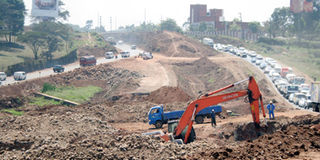Key experts left out in city roads expansion

PHOEBE OKALL | NATION
Road works under the Nairobi-Thika highway improvement project.
To residents of the now dusty Thika Road, the expansion into Kenya’s first super-highway will bring good things.
First will be an end to the traffic jam the road has become synonymous with over the past 10 years.
In the 1990s, for example, the journey from Garden Estate to the city centre took a mere 10 minutes at rush hour.
Today, it would be hard to imagine making it to Pangani within the same time, even on a weekend. It takes about an hour-and-a-half to drive the same distance.
Thika Road is also crossed near Ruiru Town by the road linking the Eastern and Northern bypasses, a 70-kilometre thoroughfare currently under construction by the China Road and Bridges Company.
Rid roads of trucks
The bypasses are intended to rid Nairobi and Uhuru Highway in particular, of the trucks that are now a permanent feature there.
Property rates have already started increasing on the two roads and indications are that the population living on that side of the Nairobi metropolitan will shoot up.
But according to experts on urban planning, the optimism that the traffic jam will come to an end with the construction of the roads into the city centre needs to be checked.
According to Prof Peter Ngau, the chairman of the Department of Urban and Regional Planning at the University of Nairobi, the government and the local authorities on the roads should also be involved in planning for the development.
“A road is not simply a transport channel; there is more that is associated with it and that can be seen in the increase in land speculation in the areas close by,” said Prof Ngau.
He said the plans to expand the road should have involved the Department of Physical Planning at the Ministry of Lands to make plans for the use of the land.
The development should also have drawn in the councils of Nairobi, Ruiru and Thika as well as the Ministry of Nairobi Metropolitan Development.
Last week, consultants overseeing work on the road said the expansion was behind schedule, saying the relocation of water, sewerage and electricity lines and underground communication cables had been the cause.
With less than 12 months to go, the first and the second lots of the project — Museum Hill to Muthaiga and Kenyatta University— have 88 per cent of work to go, while the section between Muthaiga and the university have 69 per cent left.
Prof Ngau said the involvement of planners would have increased the cost of the project — Sh26 billion — but would have resulted in more benefits for the communities and the government.
According to Mr Bosire Ogero, a former chairman of the Kenya Institute of Planners, the construction of Mombasa Road, another jam-prone highway into the city centre, is a good example of the failure to plan.
Mr Ogero said the Nairobi and Mavoko Local Authorities should not have been allowed to create plots of land right next to the Class A road, which they did.
In the case of the City Council, the creation of these plots on Uhuru Highway and Mombasa Road resulted in the development of buildings so close that there is little and in some cases no space for expansion. In the case of the Mavoko, the development of Mlolongo Town too close to the road created the jam in the area.
Both the planners use South Africa as an example of how the construction of roads and associated developments should work together in the planning as well as the implementation process.
For Prof Ngau, with proper planning, Kenya would develop such tourist attractions as Sun City, the South African resort city popular for its hotels and casinos located two hours from Johannesburg.
For now, such development would involve measures as simple as ensuring the Building Code, which sets the limits on how close buildings should be to the roads, is adhered to.




